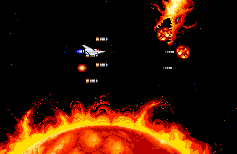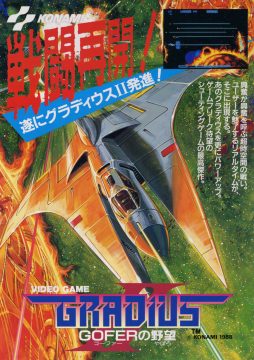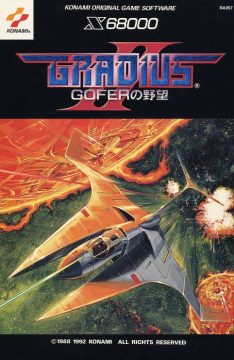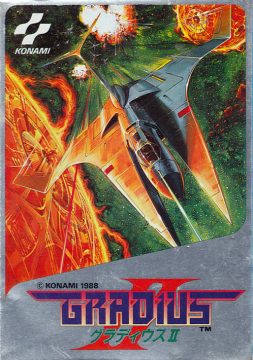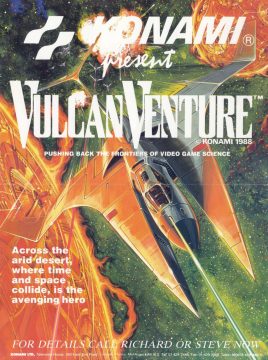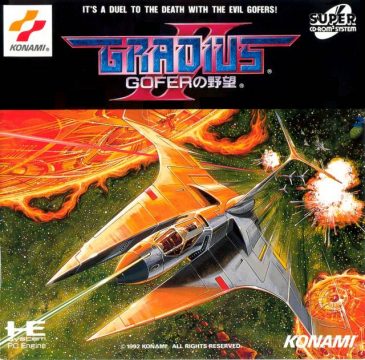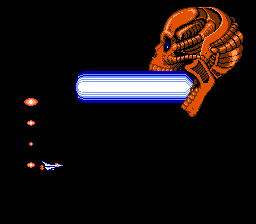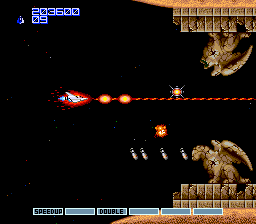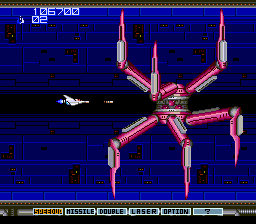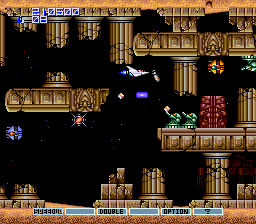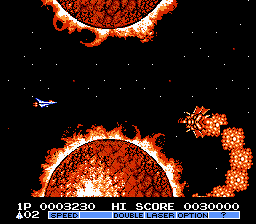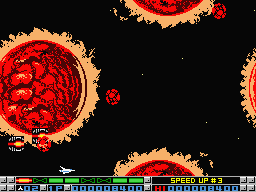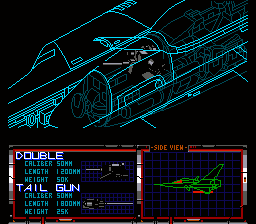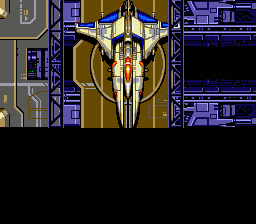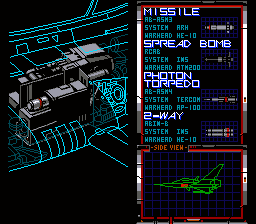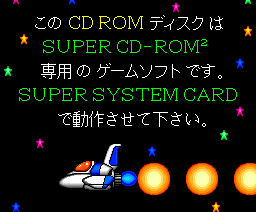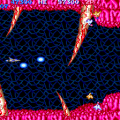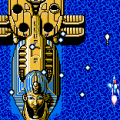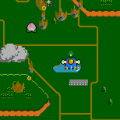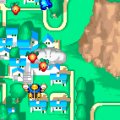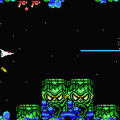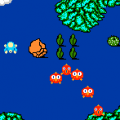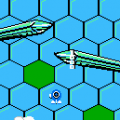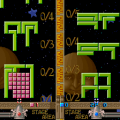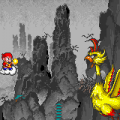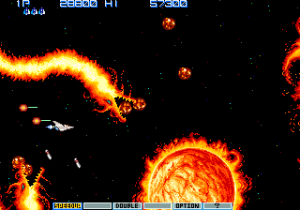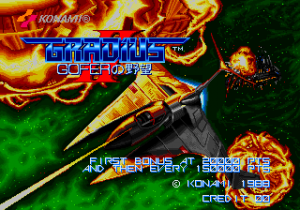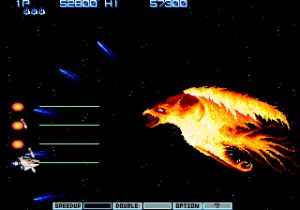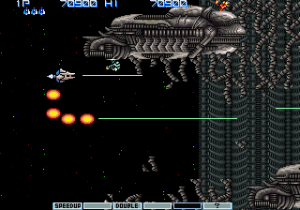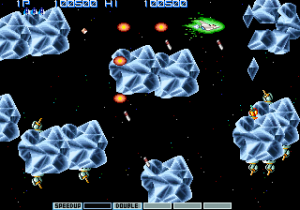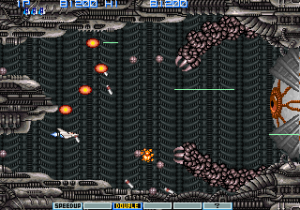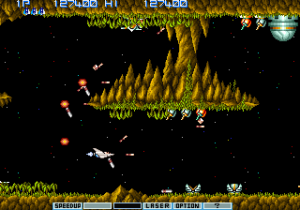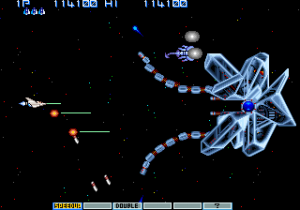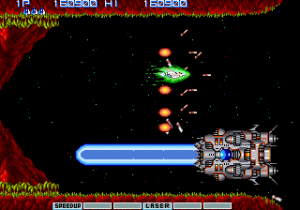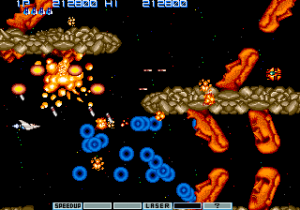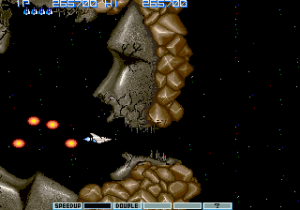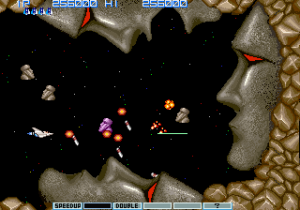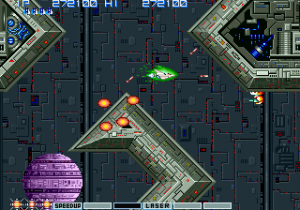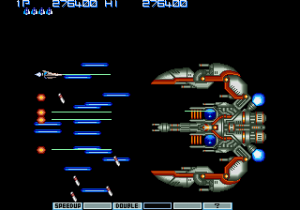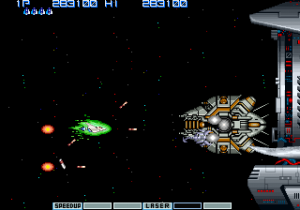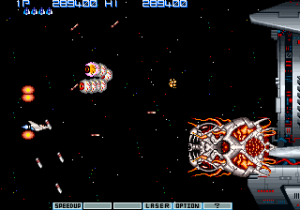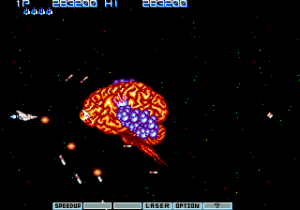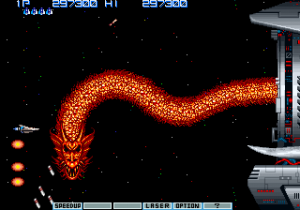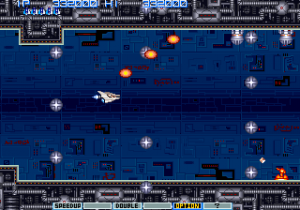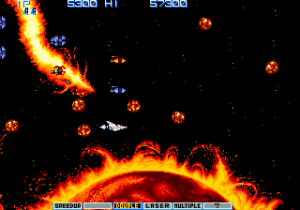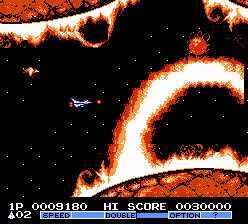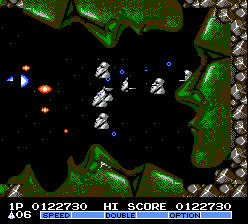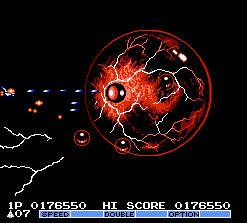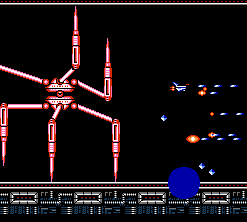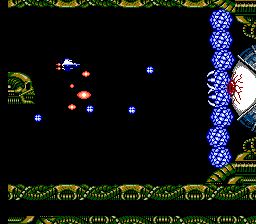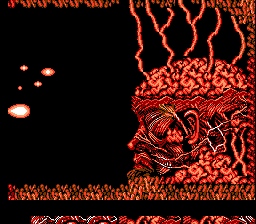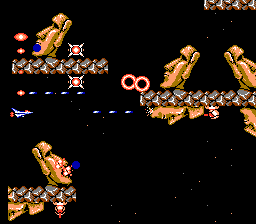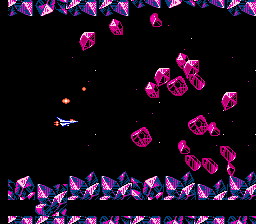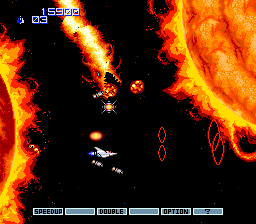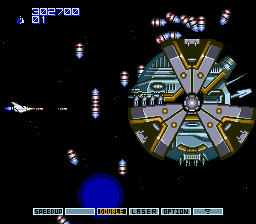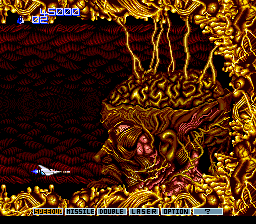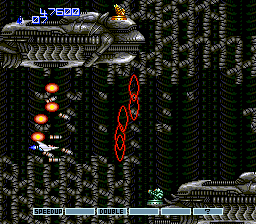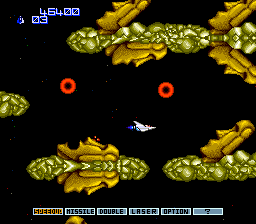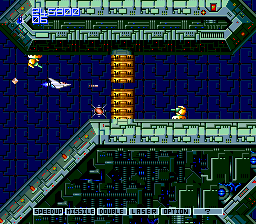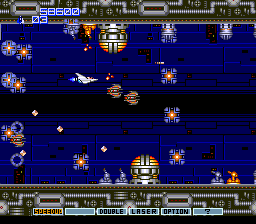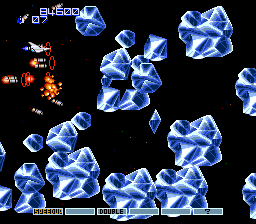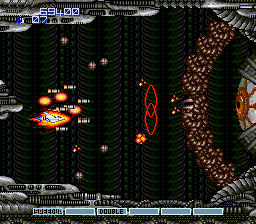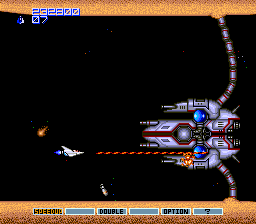Gradius II: Gofer no Yabou (“Gofer’s Ambition”), called Vulcan Venture in Europe, upgrades almost everything from the original game, and sets down most of the traditions that define the series. Running on the more powerful Konami Twin 16 board, Gradius II features some truly outstanding graphics. Right at the first level, it pulls out all the stops and has you dodging through gigantic flaming suns, each one spawning tremendous fire dragons that are absolutely huge compared to the Vic Viper.
Each stage now has a unique boss, the first of which is a massive hawk made of pure, blazing fire. The second level features an H. R. Giger inspired layout, complete with eggs that hatch little facehugger creatures straight from the Alien movies. The third stage is a fierce battle through a field of crystals, which can be shattered and broken up into smaller pieces like the classic arcade game Asteroids. The fourth stage revisits the cave level from the original game, while the fifth stage is another Moai level, which kicks into high gear when all of the Moais turn red and spew energy rings at twice the speed.
The sixth stage introduces the “speed up” zone, where the scrolling speeds up and challenges you to fly through a series of narrow corridors, inspired by the final section of Salamander / Life Force. This stage concludes with the “boss rush”, where you need to beat several bosses from both the original Gradius and Salamander, concluding with a new foe – a huge spinning globe that launches indestructible missiles from both above and below.
The final stage is another base, which begins when the walls tear themselves apart and launch towards the Vic Viper. Later, the walls begin to shift and threaten to crush the ship if you’re not careful. This ends with a battle against a gigantic mechanical spider, the Shadow Dancer, which is also completely invincible, and the only way to beat it is by dodging beneath its legs to find a safe spot until it leaves the screen.
When you start the game or when you continue, you can choose your weapon array, which consists of four different arsenal variations. Amongst the new weapons are a Spread Bomb, which drops at an arc and causes a damaging explosion when it makes contact; the 2-Way Missiles, which fires both upward and downward; the Tail Gun, which will fire shots in front of and behind the Vic Viper; and the Ripple Laser, which is less powerful than the standard laser but much wider. You can also choose from the classic Gradius shield, which protects the front part of the ship, or a larger Force Field, which is weaker but protects the entire ship.
The music is a huge step up from the chirps of the first game, featuring outstanding sound samples that are mighty impressive for an arcade board from 1988. The soundtrack was composed by Seiichi Fukami, Motoaki Furukawa, Kenichi Matsubara, and Shinji Tasaka. There are plenty of voice samples to announce which weapon you’ve selected, or clue you in on the weak spot of a boss.
The game’s biggest problem is its lack of restraint – it throws so many huge obstacles, and floods the screen with so many enemies, that it eventually grows incredibly difficult. If you get killed in the crystal fields of the third stage, you may as well just give up, because it’s immensely hard to get through with just the measly pea shooter. Thankfully, some of the home ports toned down the difficulty, which makes the game eminently more playable.
The Famicom port of Gradius II is a very reasonable conversion. Naturally, the graphics have been downgraded, but they’re about on the level of Life Force. There’s some added flickering and slowdown, but otherwise it’s replicated remarkably well. It’s also quite a bit easier, since the Famicom doesn’t have the horsepower to flood the screen with projectiles like the arcade version could. There’s also a thirty lives code, but since the game still uses a checkpoint system, it’s hardly a breeze like Contra is when using the code. Unlike the NES versions of Gradius or Life Force, you can also have four options instead of just two.
Like a lot of Konami ports, a number of other aspects have been tweaked. The first level contains an extra segment where you need to dodge Salamander-style solar flares. The second level has an additional boss, a giant skull that shoots huge light beams from its mouth. The third and fourth levels are swapped (with the boss of the third level missing) and one of the foes in the Boss Rush stage has been replaced by the Zelos Force, the final boss from Salamander.
Some of the music tracks have been changed around – one of the navigation themes has been excised, and the main boss theme has been replaced with the Shadow Dancer boss tune from the arcade version. Other than a few key songs, like these, the first and fourth stages, and the ending theme, most of the soundtrack is exclusive to the Famicom version. Like the MSX Gradius games, you can upgrade a weapon by selecting it twice. Additionally, you can select the Option again if you have a full array of them – this will order your Options to rotate around your ship for about thirty seconds.
The PC Engine version is almost graphically identical to the arcade version, just running at a lower resolution. There are brief load times after levels and some extra flicker. There’s also a new intro cinema showing off the technical details of the Vic Viper, and a new credits sequence if beaten on the highest difficult level. All of the music is CD audio, and identical to the arcade version. This version was released on the Wii Virtual Console.
The difficulty level has been fine-tuned for home play – the easiest setting here is less challenging than the easiest setting on the arcade game, but the hardest level is just as brutal. Like the Famicom version, you need to restart the whole stage when you continue, whereas the arcade version restarted you at the same checkpoint. This means you need to replay the level in the PC Engine version, but it also allows you to power-up your ship again, whereas in the arcade version, it’s too easy to find yourself in a tough spot without the means to rebuild your arsenal. The PC Engine release features a new stage, a desert with ancient ruins, which includes a new music track and a new boss.
The X68000 version is pretty much an exact port, although it runs at a slightly lower resolution and has some slowdown. It also has different music synth, as well as a new track that plays when the game loads. The PlayStation and Saturn (on the Gradius Deluxe Pack), and PSP (on the Gradius Collection) versions are straight ports of the arcade game, with the ability to tweak slowdown.
There’s also a direct sequel to this game called Gofer no Yabou: Episode II, released for the MSX. It has some similar areas to this game (like the flaming planets in the first stage) though for the most part it’s an entirely different game.
Screenshot Comparisons
PC Engine Shots
